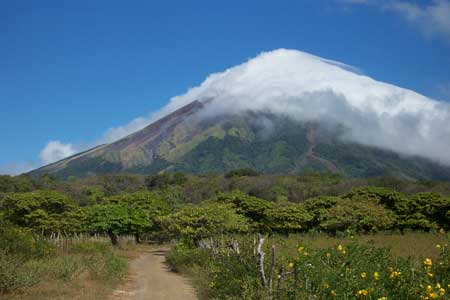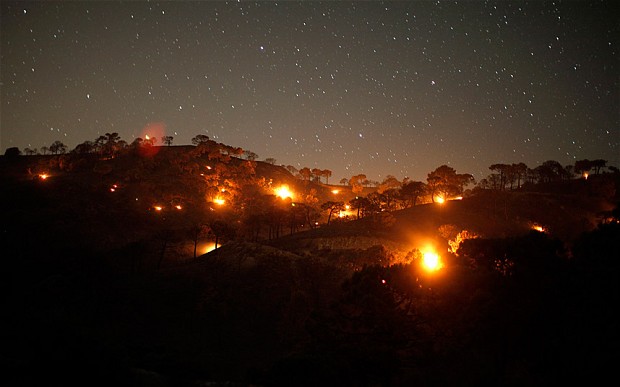
Rodeo Grande
It made perfect sense on paper, when you looked at a map: why return to Condega from Rodeo Grande through Somotillo, Chinandega, Leon, San Isidro, and Esteli, when there was so clearly a road that led from just north of Rodeo Grande to San Juan de Limay and then to Esteli? Another option, a road to Somoto (also close by) remained still unrealized. "We'll decide later," we thought, about what we'd do. The long way back home is certainly better known, more secure, perhaps easier. But to complete the circle?
The bus passes at 5:10 AM, we were told, and the point where I'd catch it lie a decent two hours' walk north of here, or perhaps more. M had walked it once before, or rather, had traversed it on horseback when it was nothing more than a trocha (footpath). Just a few weeks ago however they'd formed it into a real road with bulldozers and heavy equipment. Should be easy to follow, perhaps even an adventure. A slow tranquil day passed as we made our decision. M cut up pineapple and mangoes and I made pancakes we ate with syrup and strawberry jam. Green tea with sugar sip by sip. Lounging in the hammock in the doorway chatting about Life, the Universe, and Everything. Lounging in the tijera in her bedroom looking at pictures. The heat, the darkness of that back room, children's voices everywhere, her hound dog Maggie reclined at my feet. 'I can't believe how much she loves you,' says M.
Mid afternoon, and putting the pictures away, nap for a half hour or so. Then, waking up, the decision must be made: Do we leave then, spend the night in San Francisco del Norte (San Pancho) and catch the bus directly? Or, do we putz around the house all evening, then leave at 3AM to catch the bus, walking all night and hopefully under moonlight? Well, it was obvious: we leave tonight.
Continue reading "Fires"
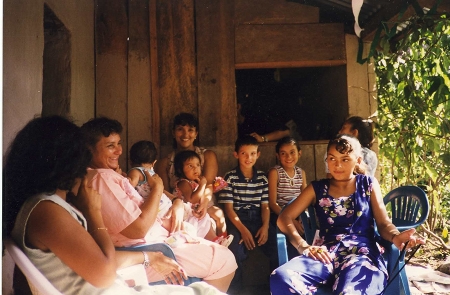
May 2002: Leaving Nicaragua after so many years it has long since felt like home to me. After such a long and lovely stay, and wondering when it is I'll return to this place I love so much, I'm intensely aware of how much I'll miss.
Here's just a taste of it:
Continue reading "Leaving (and Missing) Nicaragua"
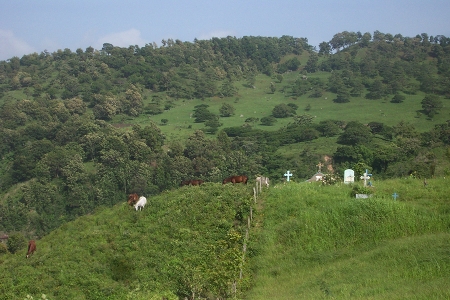
We chose, then, to escape to the North like so many times before. I would make the same journey when I'd needed space in San Diego years before, and I knew the route by heart: it went first to San Sebastian de Yali and then eastward along the mountain ridges to this quiet mountain town in Western Jinotega, where mountains crowded us on all sides and the air blews fresh and cool. For good measure, rains blew in from the West, knocking out the electricity.
So it was that at 7:30 PM, Ericka and I were transported to the previous century. The boarding house of adobe pressed around wooden columns, the meal: refried beans cooked in a heavy pan with onions, some ground beef in spices, flat tortillas toasted over a wood fire, and soft cuajada from some nearby cow.
We ate in near silence, gathered around a small wooden table that a wax candle illuminated in soft orange light. Outside the wooden door, total darkness and the sound of falling rain on the muddy streets. One hundred years ago, in the years before even General Sandino stalked these hills with his armed men, life here was little different at all.
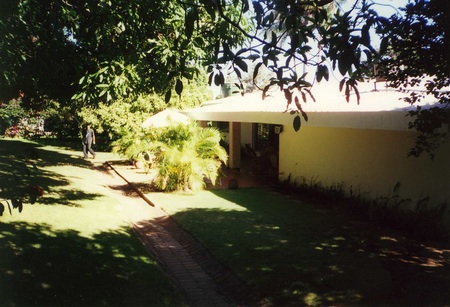
July, 2003: A violent sun that thrusts its way through the greenery of Mango and Tamarind trees. Hot air of all sides and no respite from it anywhere, least of all in the house where the fans spin the columns of blistering air through the sala and kitchen. Outside, the parrots in their cages fidget restlessly or nap with their heads under their wings.
I'm passing through shreds of memory of another life I led, not so long ago but so many worlds away – the huge house on a hill in Las Colinas where from the road I glimpse the upper canopy of those immense Mango trees. With shame I recall scolding a man who had been stealing them from a back road by poking the tree with a stick so they'd drop, only to notice I was embarrassing him in front of his young daughter, whom he pushed with him in a wheelbarrow. Why do rich neighborhoods and poor neighborhoods always abut in places like Central America? Sheepishly, I let him have the mangos, remembering I wasn't even going to be able to eat them by myself.
Continue reading "Shreds of Memory: Managua, 2003"
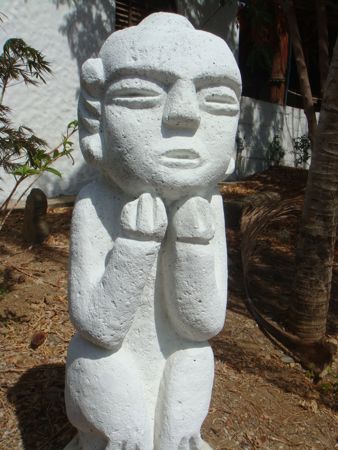
The hillsides were dry, but the little shade afforded by the almond and guanacaste trees threw into relief the concrete statues placed by the former owner: he'd reconstructed Nahuatl and Chorotega statues turned up in Ometepe and the Amerrisque mountains bearing tribute to Nicaragua's pre-Columbian history. But he'd done versions of the Buddha and a crucifix or two, as well, so the trail down to the water felt something like a parade-ground of historical dignitaries.
Continue reading "El Remanso"
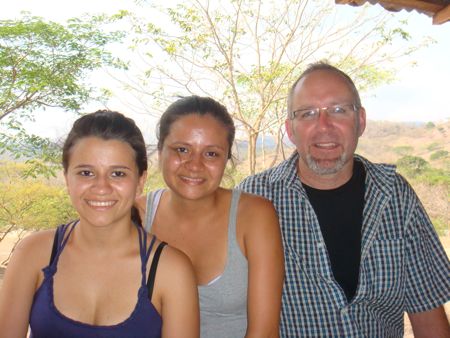
In April, 1998, after three intense months of training and cultural learning, I walked up the dusty path from the Condega-Yalí road to meet the Zavala family and begin two years of service teaching agronomy and soil conservation as a Peace Corps Volunteer. The Zavalas would be my family for the next two years, offering me a corner of their home and all their love and support as I lived in their community.
Two years later it was time to leave the Peace Corps and do something else. But I never left the family. And fifteen years — almost to the day — after I first arrived, I returned with Ericka and the children to visit. And I experienced the same whirlwind of emotions as I did in 1998.
Continue reading "San Diego at Fifteen"
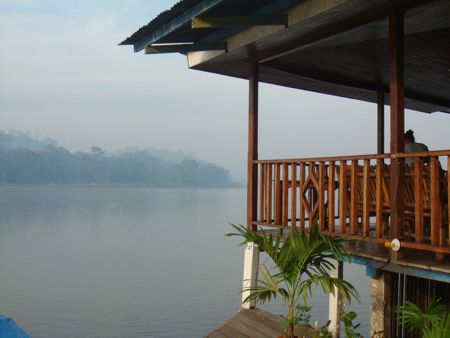
We were on the fantastic and historical San Juan River of Nicaragua, having some away time in Nicaragua's most overlooked corner. At a certain moment you look around you and think, "Holy cow, what am I doing to these kids?" You think you're a great dad, and then you realize you've trundled them off to a developing country, packed them into a single engine Piper cub for a flight just miles from an active volcano, and loaded them into a what's basically the longer version of a motorized canoe for a two-hour trip down a river hosting at least one big croc, and you start to question yourself.
But when Diego saw his first river otter sunning himself on a log, and when Valentina caught her first fish, I realized actually we were doing alright.
Continue reading "A Bend in the River"
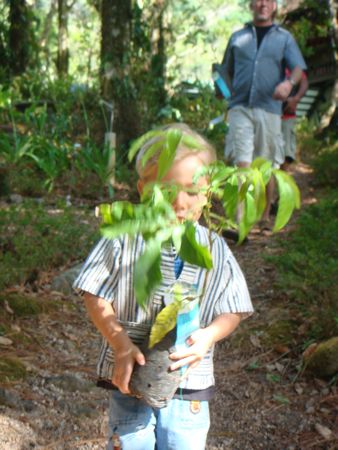
When walking the cobbled streets of Jinotega, you can't help but feel you're at the edge of the world, with all kinds of unknowns in the hills to the north and east. In fact, hundreds of kilometers of wild, lush mountain country beckon to the east. East of the city the pavement stops, the roads turn rutted and bumpy, bus service is less frequent, and the accommodations dwindle ... But the immense department of Jinotega is comprised of hundreds of small communities and thousands of farmers who make their livelihood in the hills around them &emdash; including many who have barely ever traveled beyond this land in their lives.
Continue reading "Jinotega"
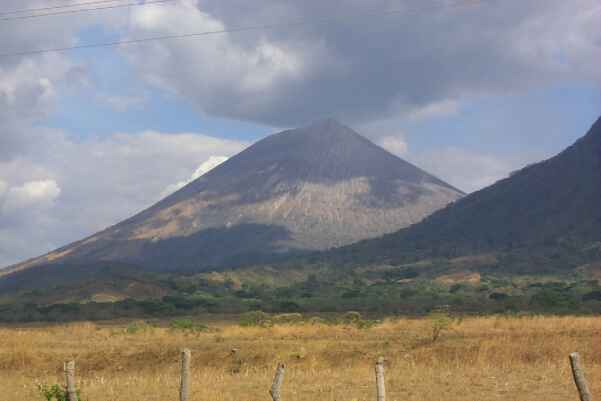
Once upon a time, the Amigos had its own web site and domain. Those days are past, and we largely use other services for staying in touch. This page allows RPCVs and others to find us in web searches, and figure out how to get in touch.
Continue reading "Amigos de Nicaragua"
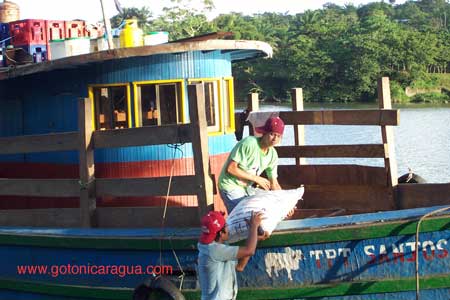
Rama's not as far out of the way as it used to be in the days before the glistening, paved highway linked it with Managua, in fact before about 2000 Rama was at the end of one of Nicaragua's most spine-crushing roads. Call Rama the town that links the Caribbean, English speaking Atlantic Coast with the Spanish speaking, cattle raising highlands of Nicaragua's interior, and treat it with all the respect of such a frontier town. In fact, a longtime riverine port and trader town, El Rama is a melting pot where Mestizo cattle traders meet Caribbean steamer captains, and dark skinned Creoles meet Nicaraguan "Spaniards" from the Pacific.
Continue reading "Rama, the Head of the River"

Thick with cool mist and rolling countryside, surrounded on all sides by coffee but not itself a coffee town, the little mountain pueblo of San Rafael del Norte is one of my favorite destinations and one of the towns that best evokes for me the spirit of Nicaragua's rugged north. As we wrote in Moon Nicaragua, to know San Rafael del Norte is to know Nicaragua's history. General Cesar Augusto Sandino made this wild corner his home for a while as he staked out positions against the US Marines and formed his philosophy of rugged determination, nationalism, and independence. That his philosophy and name were later co-opted into the basis of the Sandinista party is another story, one that the locals certainly would not be much interested in hearing.
Continue reading "San Rafael del Norte"
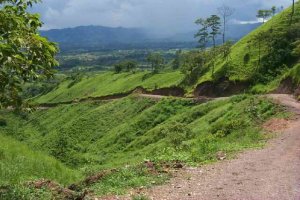
The following is from a letter to a friend, and is a memoir of life in the Peace Corps in a little mountain hamlet of northern Nicaragua
19 April, 1999
El Hato is a little mountain community too small to even merit the word "town." It consists of about a dozen houses set at the intersection of two little mountain roads, both dirt and compacted by the hooves of the horses and cattle and foot traffic that circulate on them. One road would take you, after a couple of hours of walking, to an even higher settlement called Sialcuna perched on a mountain ridge overlooking to one side, El Hato, and to the other, the Coco River. From El Hato that ridge forms a backdrop, a half circle of mountain peaks at whose feet we are located. There are still a few pine trees in those hills, and between here and there you'll see a heavy black vulture or two flying loops in all that sky.
Continue reading "If You Were to Visit Me in El Hato"
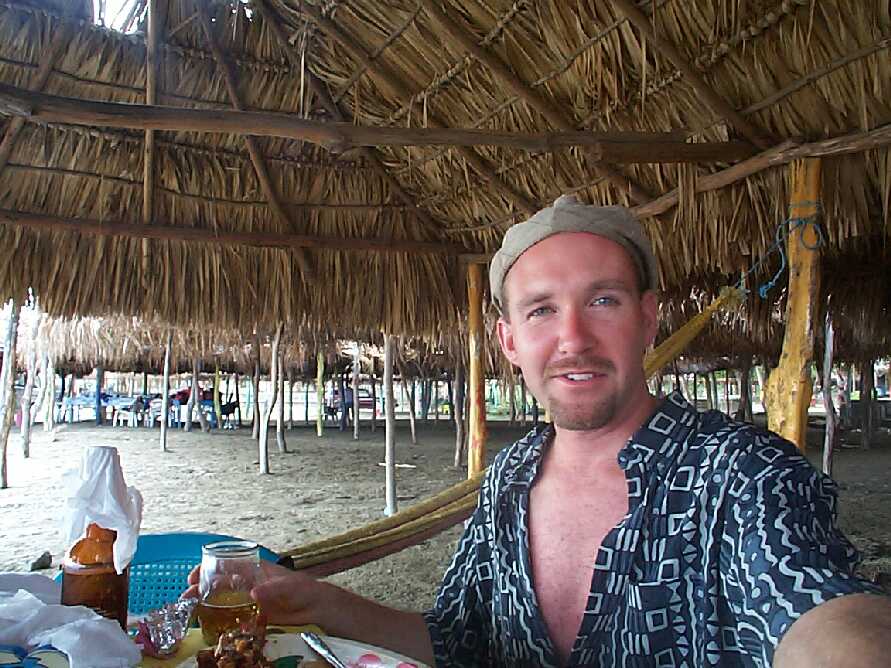
They arrived with everything under the sun. The sun, that piercing sun that boiled their enthusiasm and faded their clothing. Enthusiasm - they stepped onto the runway tarmac with that too, as well as two checked pieces of luggage each and a carry-on of the proper dimensions. It wasn't long before they were sweating: the things they carried weighed a lot.
The things they carried were going to, in turn, carry them-twenty two fresh faced aspirantes called Nica Fifteen-through two years of the toughest job they'd ever love. They had, among other things in those sixty-six bags, exactly what Peace Corps had recommended: three months of shampoo and prescription meds, comfortable shoes, and long sleeved cotton 'nun' dresses. There were cassette players and address books, t-shirts and dozens of pairs of underwear still virgin to be sacrificed to the gods of barbed wire, lavandero, and sol. There were paperbacks and new journals of crisp white pages for recording all the wonder. There were cameras and water bottles and ballcaps and ballpoints. All in all, the things they carried were rather homogenous.
But the new aspirantes were individuals ...
Continue reading "The Things They Carried"

Most Nicaraguans live their entire lives in the shadow of one volcano or another. Particularly striking is the road from Managua to Chinandega via León, which tracks along the bases of the Maribio volcanoes. They are tremendous.
Experience what it's like to live under the shadow of these active volcanoes. From L to R: San Cristobal, La Casita, Telica, Cerro Negro, El Hoyo
Continue reading "Under the Shadow of Giants"











